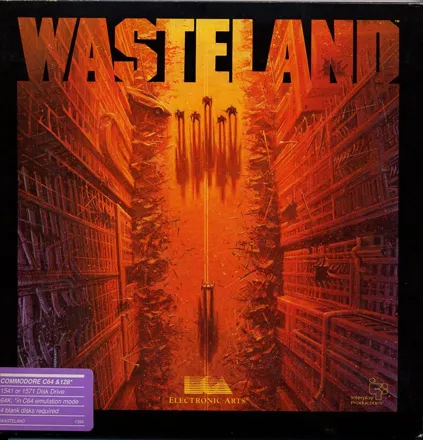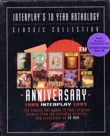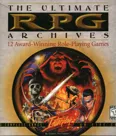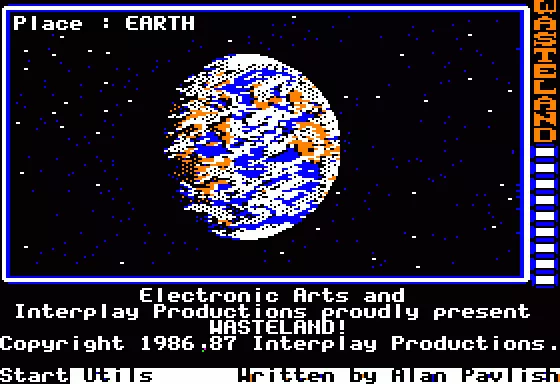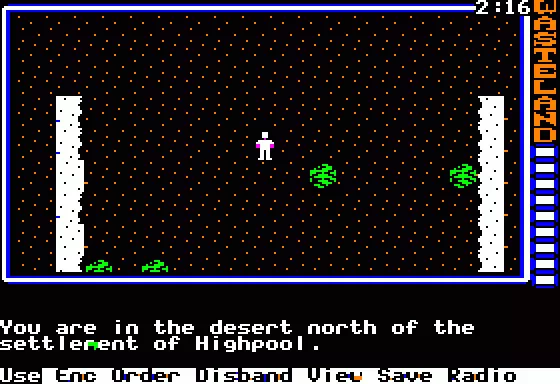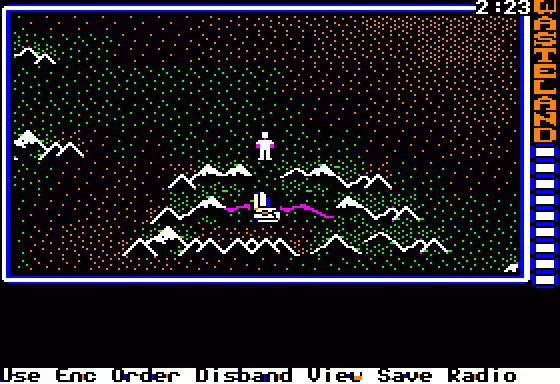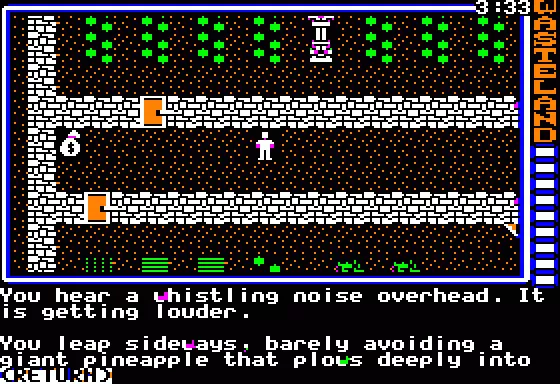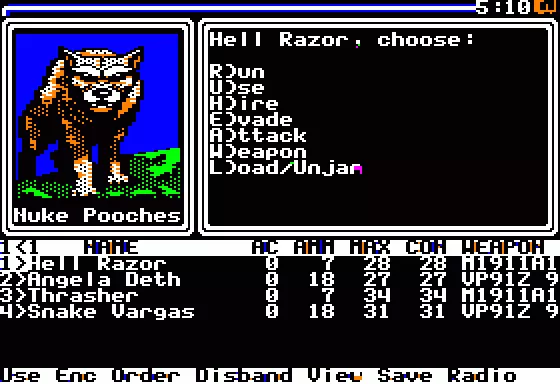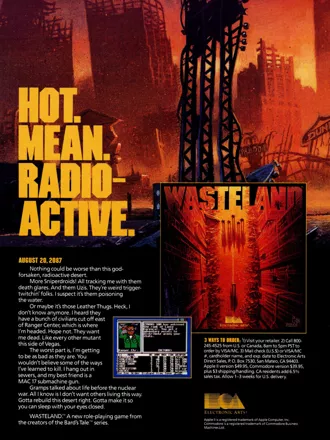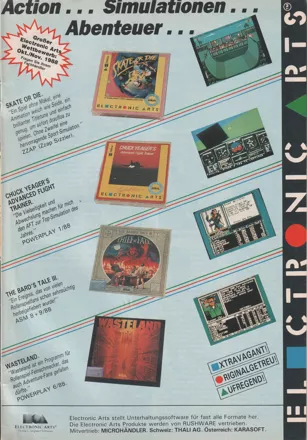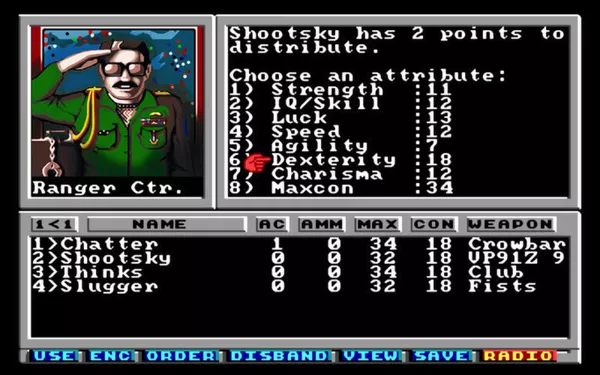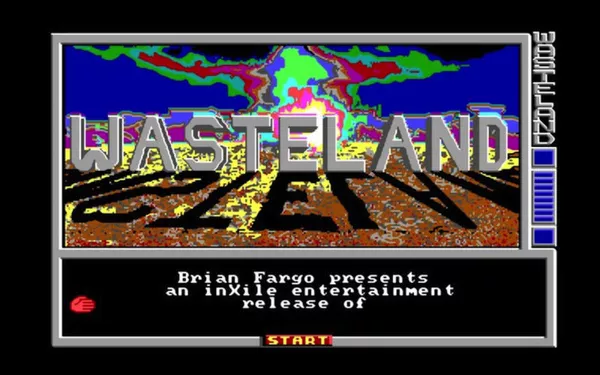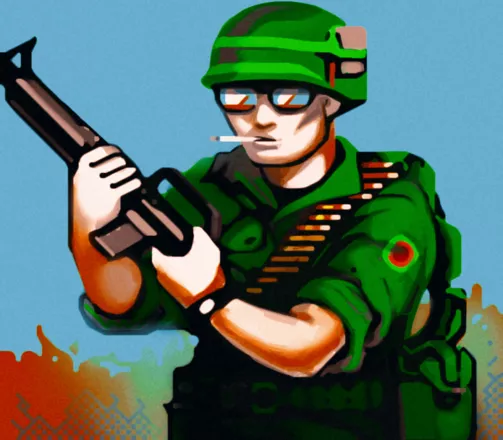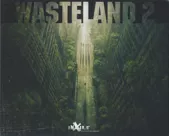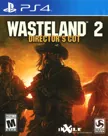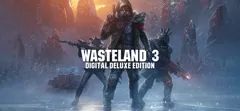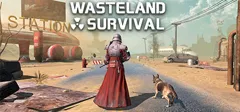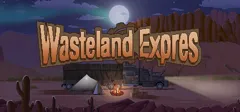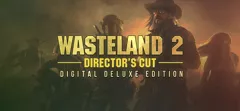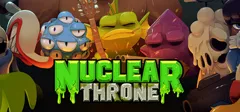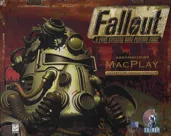Wasteland
Description official descriptions
Wasteland takes place in the future after the nuclear holocaust of World War III. The player guides band of Desert Rangers from town to town, gradually uncovering a sinister plot that threatens what's left of mankind.
Much of the game is played like most other RPGs of its time: the player navigates the party through the top-down world, fights enemies (which appear randomly in hostile areas) in turn-based style on combat screens represented by enemy pictures, acquires information, equipment, and items from NPCs in towns, etc. The player can create a whole party of adventurers and/or recruit some of the characters that populate the game's world.
However, Wasteland also introduced an original skill system that has had a significant influence on the genre. The game makes use of the skill system in conjunction with traditional character attributes to achieve goals and get past obstacles. Beside helping the characters to fight more efficiently, main attributes sometimes have an impact on activities used outside of combat. For example, high strength can be applied to break a heavy object, charisma rating might influence the way NPCs interact with the main character, etc.
The skills work in a similar way: some of them improve the characters' proficiencies with different types of attacks and weapons, while others are needed to solve and/or by pass certain situations during interaction with the game's characters and objects. These skills are rather diverse, ranging from physical abilities such as swimming to more complex actions (medic, lock-picking), or even psychological states (confidence). Skill learning and progression depend on the main character's IQ rating.
Groups +
Screenshots
Promos
Credits (Commodore 64 version)
19 People
| Design | |
| Scenario Design | |
| Graphics | |
| Testing | |
| Producer | |
| Assistant Producers | |
| Art Director | |
| Front Cover Art | |
| Package Design |
Reviews
Critics
Average score: 83% (based on 18 ratings)
Players
Average score: 3.6 out of 5 (based on 164 ratings with 13 reviews)
Super game. Got it at a yard sale and was hooked.
The Good
Different ways to do things was good, such as what to do at Fat Freddy's. Weapons jammed, different things at different shops. You could blow through trash walls, and find a gang. It was random to me the first few times. I would recommend this game to others.
The Bad
Lack of cash without cheating and the Vegas sewers.
The Bottom Line
A great game if you like old games. Try it even if you aren't a old game fan. You will like SOMETHING about it.
DOS · by Joe McCarthy (1) · 2003
The seminal post-apocalyptic CRPG
The Good
Given the limitations of the hardware of the time, this was an amazing game which prefigured almost all the best features of the more modern title, Fallout.
The post-apocalyptic setting allowed for the combination of recognizable modern objects and weapons with a completely unknown wilderness, and the actual story was complex and interesting.
The recognizability of things was particularly important because it allowed item descriptions to be terse without failing to inform. On a 48K machine with 140K disks, keeping descriptions down to 20 characters or so allowed for a much bigger world.
The Bad
Although it was "realistic" and designed to be part of game balance, the extremely limited finite ammunition supply combined with the possibility of random monster encounters could make the game very frustrating. (Luckily, there was an exploitable design feature in the Apple ][ version that let you overcome this.)
The Bottom Line
One of those games that is original and fun to play, and seminal in the development of the industry. An engaging story and world to explore, and in every way a worth ancestor to Fallout.
Apple II · by weregamer (155) · 2003
I cut my gaming teeth on this game and haven't been satisfied since
The Good
the best aspects of this game is that is scripted like a book. Wonderful storyline, funny hidden jokes, a great, fundamentally sound idea as a basis, also It had a depth of character unlike any i have seen. In the food world the rpg games today are like a cheap cola, but it was a fine wine. It was very well thought out, but also it was very well felt out.
The Bad
The knock on this game is the knock on any game of it generation, the graphics. It was born in an era when the graphics were poor by todays standards. Today the standard game graphics has is something like a high resolution "quake" type 3d graphics, wastelands was closer to a 8 bit first generation nintendo type graphics.
The Bottom Line
wasteland is like a book. it doesn't have the same sensational splash as the new ones that just came out. But, what it had in writting, depth of character, & empathy, will surely make it a classic for years to come.
DOS · by JASON chamberlain (2) · 2000
Discussion
| Subject | By | Date |
|---|---|---|
| Wasteland 2? | Pseudo_Intellectual (67771) | Mar 18, 2012 |
Trivia
Apple II version
The original version of this game, for the Apple II, used a clever technical trick, effectively virtualizing the huge game world onto four disk sides. Only the part of the world the player was currently capable of interacting with was actually in memory at any given time, and the rest was stored on disk. The division across disks corresponded to geographical boundaries on the world map, so there was no problem with data straddling disk boundaries.
The game shipped on both sides of two disks, completely write-protected. To play, you copied all four disk sides to your own writable floppies, and then booted off of the copy of disk 1.
Cancelled sequel
Interplay had planned a sequel called Meantime that was due in 1989 for the Apple II. Source code was virtually completed but when the Apple II market died. It was then deamed too expensive to re-write the code to the IBM.
The sequel involved the idea of time-travel and recruiting various important historic figures (think Bill and Ted's Excellent Adventure). For more information on Meantime, read "Fallout Bible issue 8" interview with Bill Dugan.
Later, Interplay attempted to revive the game once more, but Electronic Arts held rights to the title. The game evolved into what we know today as Fallout, a spiritual succesor to Wasteland that, except for some minor references, is set in a different universe.
A proper sequel would not be made until Wasteland 2 in 2014, by which time the IP was acquired by Brian Fargo's company inXile Entertainment.
Credits
The credits listed in this entry are a hybrid; the IBM credits have been added and overlaid on the Apple credits to make a complete MobyGames IBM PC entry.
Cover
The original packaging contained a photo of the seven main developers dressed in Wasteland gear. This photo, in silhouette, is on the cover of the manual and Survival Guide. (see the Covers section).
Development
Some of the mappers on Wasteland were brought on as summertime employees for Interplay and now have careers in the game industry.
Engine
The game engine used for Wasteland was also used in the pseudo-sequel, Fountain of Dreams.
Manual
Wasteland was released with a book of text paragraphs. Specific encounters would refer players to a paragraph number for a verbose description of what was occurring. To keep players from scanning the book for clues, there were two full versions of the major story. One was the actual plot of the game and the other was a decoy involving the major settings and characters but with an entirely different explanation for the events. After completing the game, you could skim through the book and get a second (albeit cheesy) story.
Packaging
Wasteland originally came out in the classic album-square EA box for the C-64 - later versions were in the more traditional small box packaging.
References
- There are references to the game designers and their previous games in Wasteland. The two most common are the obvious spell references to The Bard's Tale in the occult shop in Needles, and the character Faran Brygo in Vegas (obviously taken from Brian Fargo). Another obvious one is an arm patch worn by a 'Pistolero' -- it's the old Interplay logo. Finally, the room in Vegas with the Proton Ax has the initials "A.P." (for the developer Alan Pavlish) as a wall design.
- The makers of Wasteland hid their own version of the Red Ryder 200-shot Carbine Action Air Rifle in the town of Highpool. You can "seek out" and battle (and kill the disappointingly weak) Red Ryder and claim his Red Ryder Gun for your very own.
Awards
- Computer Gaming World
- October 1988 (Issue #52) - Adventure Game of the Year
- February 1993 (Issue #103) – Introduced into the Hall of Fame
- November 1996 (15th anniversary issue) - #9 in the “150 Best Games of All Time” list
- November 1996 (15th anniversary issue) – #9 Most Memorable Game Villain (Scorpitron)
Information also contributed by Adam Baratz, ClydeFrog, DreamWeaver, LepricahnsGold, Mirrorshades2k, PCGamer77, RedRyder, rstevenson, weregamer and woods01.
Analytics
Related Sites +
-
Desolation!
Home page for an LP MUD based on Interplay's CRPG, Wasteland. -
Snake Squeezins
A Yahoo! group for discussion about Wasteland. -
The "Wasteland" article at The Vault, a Fallout wiki
This is an article found on the Fallout wiki, The Vault. It mentions, among other things, that Wasteland is not the prequel to Fallout but the inspiration. -
The Desert Ranger Outpost
One of the best resources for Wasteland. -
The Wasteland Ranger HQ-Grid
Another fantastic resource for all things Wasteland. -
UHS Hints for Wasteland
Question and answer type game guide gives you just the help you need.
Identifiers +
Contribute
Are you familiar with this game? Help document and preserve this entry in video game history! If your contribution is approved, you will earn points and be credited as a contributor.
Contributors to this Entry
Game added by Trixter.
Commodore 64 added by Quapil. Apple II added by KnockStump. Macintosh, Linux, Windows added by Sciere.
Additional contributors: bassaf, Jeanne, LepricahnsGold, Patrick Bregger, Plok.
Game added October 9, 1999. Last modified February 4, 2025.


